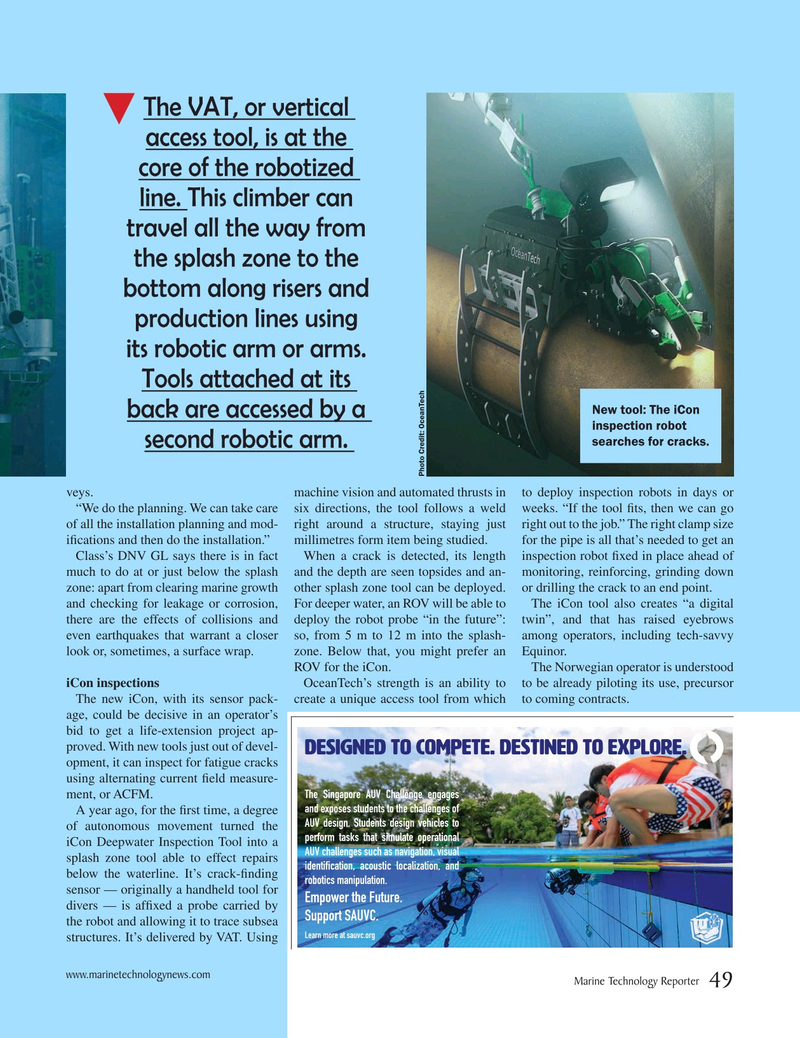
Page 49: of Marine Technology Magazine (January 2020)
Read this page in Pdf, Flash or Html5 edition of January 2020 Marine Technology Magazine
The VAT, or vertical access tool, is at the core of the robotized line. This climber can travel all the way from the splash zone to the bottom along risers and production lines using its robotic arm or arms.
Tools attached at its
New tool: The iCon back are accessed by a inspection robot searches for cracks.
second robotic arm.
Photo Credit: OceanTech veys. machine vision and automated thrusts in to deploy inspection robots in days or “We do the planning. We can take care six directions, the tool follows a weld weeks. “If the tool ? ts, then we can go of all the installation planning and mod- right around a structure, staying just right out to the job.” The right clamp size i? cations and then do the installation.” millimetres form item being studied. for the pipe is all that’s needed to get an
Class’s DNV GL says there is in fact When a crack is detected, its length inspection robot ? xed in place ahead of much to do at or just below the splash and the depth are seen topsides and an- monitoring, reinforcing, grinding down zone: apart from clearing marine growth other splash zone tool can be deployed. or drilling the crack to an end point. and checking for leakage or corrosion, For deeper water, an ROV will be able to The iCon tool also creates “a digital there are the effects of collisions and deploy the robot probe “in the future”: twin”, and that has raised eyebrows even earthquakes that warrant a closer so, from 5 m to 12 m into the splash- among operators, including tech-savvy look or, sometimes, a surface wrap. zone. Below that, you might prefer an Equinor.
ROV for the iCon. The Norwegian operator is understood iCon inspections OceanTech’s strength is an ability to to be already piloting its use, precursor
The new iCon, with its sensor pack- create a unique access tool from which to coming contracts. age, could be decisive in an operator’s bid to get a life-extension project ap- proved. With new tools just out of devel-
Designed to compete. destined to explore.
opment, it can inspect for fatigue cracks using alternating current ? eld measure-
The Singapore AUV Challenge engages ment, or ACFM.
and exposes students to the challenges of
A year ago, for the ? rst time, a degree
AUV design. Students design vehicles to of autonomous movement turned the perform tasks that simulate operational iCon Deepwater Inspection Tool into a
AUV challenges such as navigation, visual splash zone tool able to effect repairs identification, acoustic localization, and below the waterline. It’s crack-? nding robotics manipulation.
sensor — originally a handheld tool for
Empower the Future.
divers — is af? xed a probe carried by
Support SAUVC.
the robot and allowing it to trace subsea
Learn more at sauvc.org structures. It’s delivered by VAT. Using www.marinetechnologynews.com
Marine Technology Reporter 49
MTR #1 (34-49).indd 49 1/21/2020 4:50:34 PM

 48
48

 50
50
